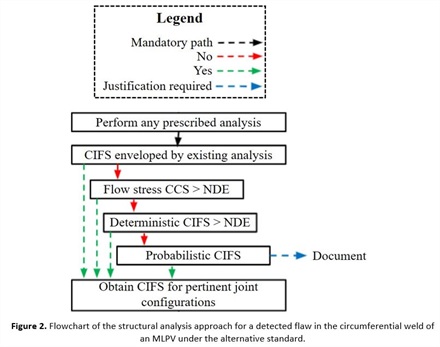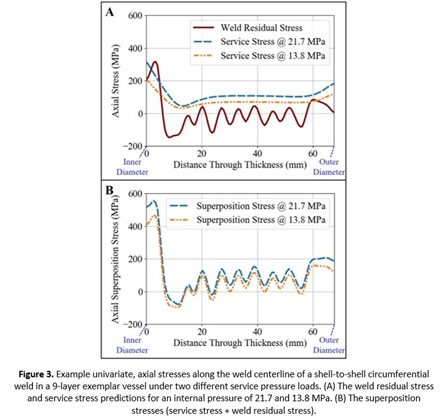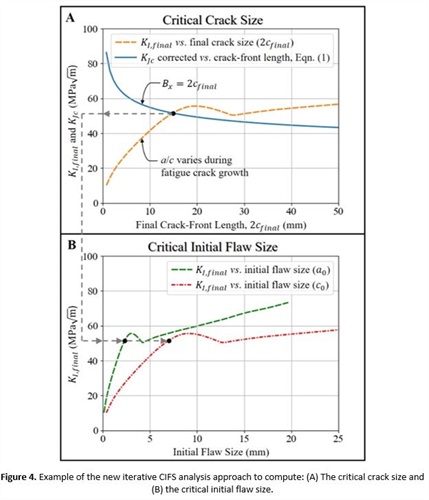OSMA-Funded Research Provides Improved Methods for Fitness-For-Service Assessments of Ground-Based MLPVs
The Office of Safety and Mission Assurance (OSMA) is currently engaged in a multi-year program to develop continued use fitness-for-service approaches and sustainment logic for aging ground-based Multi-Layered Pressure Vessels (MLPVs).
History of MLPVs at NASA
Since the 1950s, NASA has used carbon steel MLPVs as a critical part of its space flight center and research center operations.
Many of these MLPVs were designed and manufactured before the inclusion of MLPV construction requirements in the American Society of Mechanical Engineers (ASME) Boiler and Pressure Vessel code, when the field of fracture mechanics was in its infancy.
As a result, several of the steels used in these non-code vessels are at a risk of cleavage fracture within the operating temperature ranges at NASA sites where the vessels are installed.
Additionally, missing construction records and the use of proprietary materials make fitness-for-service assessments and traditional evaluations of these non-code MLPVs significant challenges.
Additional aspects of this program include identifying and maturing Non-Destructive Evaluation (NDE) techniques and characterizing the materials used in MLPV construction through limited destructive testing to obtain appropriate material properties for the MLPVs.
"This program has led to the successful creation of an alternative standard for fitness-for-service assessments for ground-based MLPVs operated across NASA centers,” said Cliff Arnold, OSMA program executive for Pressure Systems.
NASA currently operates roughly 360 non-code MLPVs. The agency’s MLPV fleet has a wide variety of geometries and layer quantities varying from 3- to 32-layer. The replacement cost of the vessels in the fleet is prohibitive.
NASA’s MLPVs are under continuous cyclic loading during operation, as the vessels are regularly being pressurized and depressurized throughout the day to support various activities across NASA centers, such as wind tunnel operations.
While the vessels are rarely fully depressurized, the small pressurization and depressurization cycles are a driver for fatigue crack growth.
Recently, the OSMA-funded research team developed practical methodologies that Center Pressure System managers can use to support continued fitness-for-service assessments for aging vessels.
 One of the key methodologies is a damage tolerance approach that involves computing the crack sizes in key vessel locations that could cause catastrophic failure of the vessel, referred to as the Critical Initial Flaw Size (CIFS), and the Critical Crack Size (CCS).
One of the key methodologies is a damage tolerance approach that involves computing the crack sizes in key vessel locations that could cause catastrophic failure of the vessel, referred to as the Critical Initial Flaw Size (CIFS), and the Critical Crack Size (CCS).
NASA is assessing MLPVs over a 40-year cyclic loading schedule. However, until recently, one of the biggest challenges for these analyses was accounting for the possibility of cleavage fracture in the assessments.
CIFS and CCS
The CIFS is defined as the initial flaw size/shape that grows to just reach a fracture critical flaw size/shape at completion of a specified cyclic loading schedule.
The CCS is the fracture critical flaw size/shape at which the maximum stress-intensity factor along the front of the growing crack reaches the vessel material toughness.
Put simply, the CIFS is the initial flaw size/shape that grows to the CCS after the cyclic loading schedule.
To combat this challenge, the research team developed a CIFS analysis approach for cleavage fracture that employs the NASGRO® software, which is a sophisticated fracture and fatigue analysis package that is currently being used by Pressure Systems managers for fitness-for-service assessments.
The team is also developing probabilistic approaches to understand the impact of uncertainty in vessel geometry, loading and material properties on the CIFS and CCS predictions.
Critical Initial Flaw Size Analysis Approach for Cleavage Fracture
NASGRO® has built-in capabilities for computing CIFS and CCS, but these standard procedures do not account for cleavage fracture toughness.
Cleavage fracture is unstable crack growth initiating from a weak location along the crack front, and cleavage fracture toughness is characterized by weakest-link behavior.
The new analysis approach accounts for cleavage fracture by changing the fracture toughness as a function of the crack-front length as the crack grows, which is currently not an option in NASGRO®.
This new approach also supports CIFS analysis for flaws that change shape during fatigue crack growth. Currently, NASGRO’s® standard CIFS computations assume that the shape of the flaw remains fixed throughout fatigue crack growth, and the flaw is scaled proportionally based on the crack size.

However, some of the key regions of the vessel that are being investigated have stresses with a strong spatial variation on the crack plane, such as the circumferential and longitudinal welds.
The new analysis approach uses a Python wrapper script to run NASGRO fatigue crack growth computations, extract data from NASGRO® output files and compute the CIFS and CCS based on the extracted data.
The CCS is computed by determining the final flaw size/shape after fatigue crack growth, at which the stress intensity factor is greater than or equal to the cleavage fracture toughness.
The CIFS is computed by determining the starting flaw size/shape that grew to the CCS over the specified cyclic loading schedule. This approach is straightforward and relatively fast, and the Python wrapper script saves significant time compared to manually performing the iterative calculations.
The research team ran several of these CIFS and CCS analyses for flaw cases in the circumferential welds of three exemplar vessels in NASA’s fleet. They performed these analyses for a range of operational temperatures and internal pressures to build helpful CIFS and CCS interpolation tables.

For flaw cases bounded by these pre-run analyses, users can estimate the CIFS and CCS for a variety of operational temperatures and pressures by interpolating the results.
Probabilistic models are also being developed to predict the CIFS and CCS cumulative distribution functions at different minimum operational temperatures to understand the impact of uncertainty on the critical flaw size predictions and to give Pressure System managers additional information regarding risk to support the decision-making process.
The NDE team is already using these CIFS and CCS results to help determine required detection flaw sizes, and the results will be used to help estimate the critical sizes for flaws detected in the circumferential weld during future NDE inspections.
This OSMA-funded research provides Pressure Systems managers with practical methods and tools for performing fitness-for-service assessments of the aging MLPV fleet and making informed decisions about the operation of their systems to ensure safety while extending the life of critical infrastructure.
“NASA’s ground-based MLPVs and pressure systems are mission-critical infrastructure, and this research supports space flight innovation and future NASA missions,” said Arnold. “Additionally, the findings and developments from this research are being made available to the public and can be used by other industries to support MLPV sustainment and Pressure System management.”
For more information, contact Arnold.